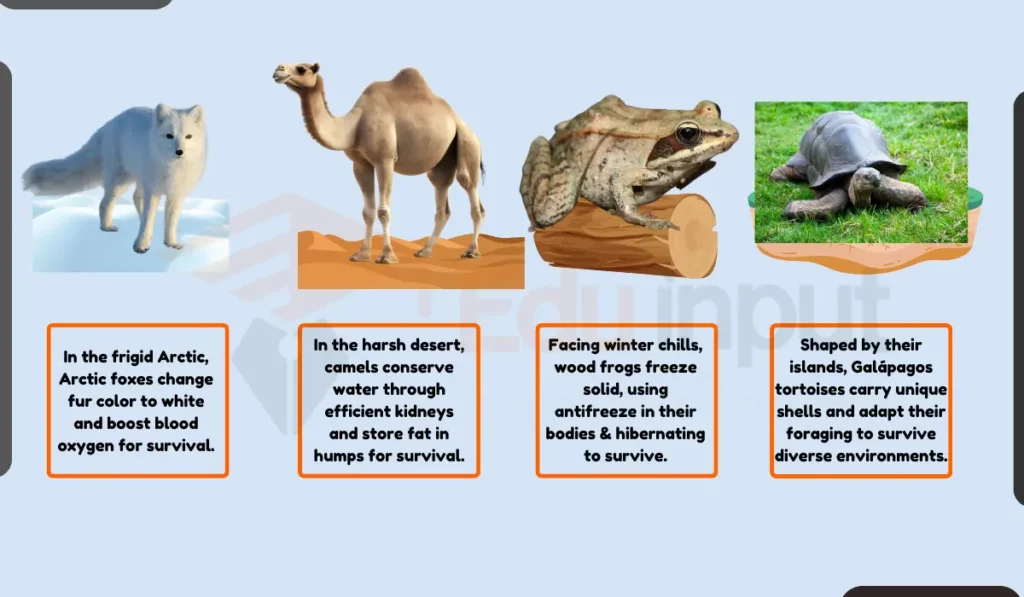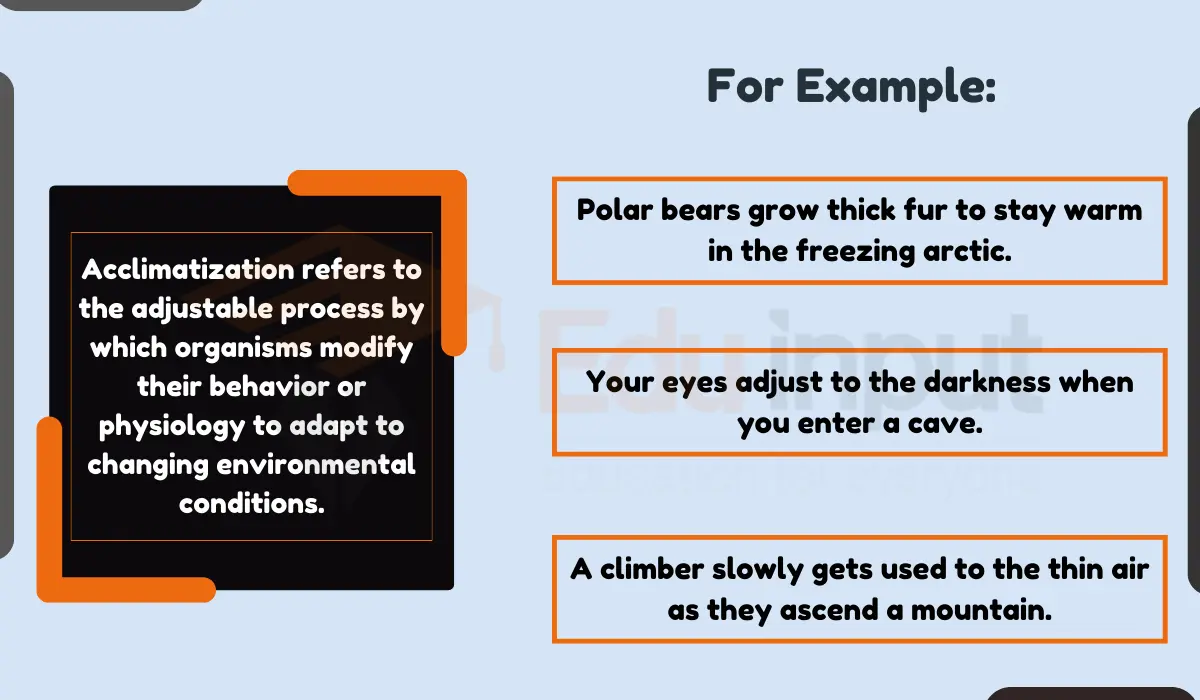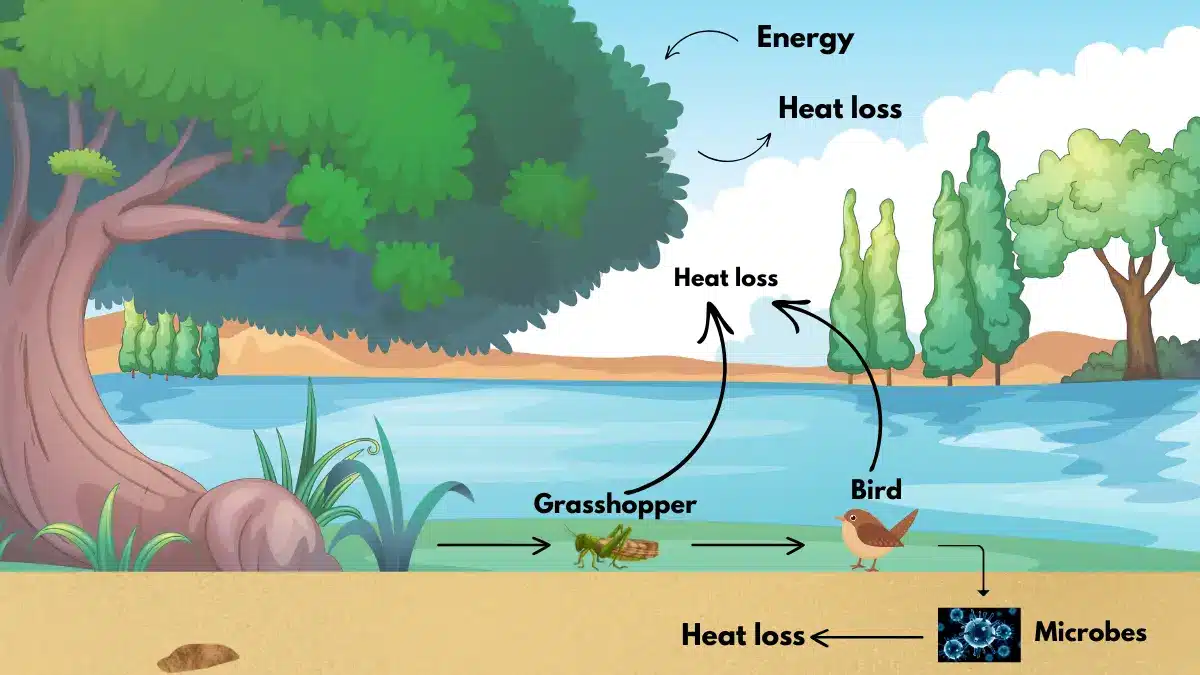12 Examples of Acclimatization in Animals
Polar bears wear thick fur coats to stay warm in the cold, while camels have humps that store food and water for the hot desert. Wood frogs freeze solid like popsicles in winter, and birds use the stars like a map to fly long distances. Even tortoises in the Galápagos Islands have different shaped shells depending on what they eat. These are just a few examples of how animals adjust to their homes.

Examples of Acclimatization in Animals
Here are some Examples of Acclimatization in Animals:
1. Arctic Fox
Environment: Extreme cold temperatures of the Arctic region.
How They Acclimatize?
Physical change: Arctic foxes exhibit a change in fur color during winter, turning white to blend with the snowy surroundings. This camouflage aids in hunting and protection against predators.
Physiological change: Arctic foxes have higher concentrations of hemoglobin in their blood, enhancing oxygen transport in cold conditions.
2. Camel
Environment: Arid desert conditions with high temperatures and scarce water resources.
How They Acclimatize?
Physiological change: Camels have evolved efficient kidneys that conserve water, allowing them to survive long periods without drinking.
Behavioral change: Camels store fat in their humps, providing energy during food scarcity. They also minimize water loss by minimizing sweating and panting.
3. Wood Frog
Environment: Cold climates with freezing temperatures.
How They Acclimatize?
Physiological change: Wood frogs employ cryopreservation, allowing their bodies to freeze during winter. They produce glucose and glycogen, which act as antifreeze, preventing ice crystals from forming in their cells.
Behavioral change: Wood frogs undergo a period of hibernation during winter, reducing their metabolic rate and minimizing energy expenditure.
4. Himalayan Tahr
Environment: High-altitude mountainous regions.
How They Acclimatize?
Physiological change: Himalayan tahrs have larger lungs and increased red blood cells, enhancing their oxygen-carrying capacity. These adaptations allow them to breathe efficiently at high altitudes.
Behavioral change: Himalayan tahrs spend more time in lower altitudes during the night, when oxygen levels are higher.
5. Migratory Birds
Environment: Seasonal changes in temperature and food availability.
How They Acclimatize?
Behavioral change: Migratory birds have excellent navigational skills. It allows them to travel thousands of kilometers to their breeding grounds and feeding grounds. They also adjust their flight patterns and fuel consumption based on weather conditions.
Physiological change: Migratory birds undergo physiological changes, such as increasing their fat stores, to prepare for long-distance flights.
6. Galápagos Tortoise
Environment: Varying climates on different islands of the Galápagos archipelago.
How They Acclimatize?
Evolutionary change: Galápagos tortoises have adapted their shell shapes and sizes based on the vegetation available on their respective islands. Tortoises on islands with denser vegetation have wider shells to store more food, while those on islands with less vegetation have narrower shells to conserve heat.
Behavioral change: Galápagos tortoises may alter their foraging behavior based on the availability of food sources on different islands.
7. Elephant Seal
Environment: Marine environments with varying temperatures.
How They Acclimatize?
Physiological change: Elephant seals have a thick layer of blubber for insulation. It allows them to survive in cold water. They also have a large heart that can pump blood efficiently to their extremities.
Behavioral change: Elephant seals undergo a period of molting on land, during which they shed their old fur and blubber. They conserve heat by huddling together during this time.
8. Pika
Environment: Alpine regions with temperature extremes.
How They Acclimatize?
Physical change: Pikas develop thicker fur during winter to conserve heat. They also have a layer of fur on their feet that helps them grip ice and snow.
Behavioral change: Pikas store vegetation as haypiles for sustenance during harsh winter conditions. They may also burrow underground to escape extreme cold.
9. Sand Gazelle
Environment: Desert environments with high temperatures.
How They Acclimatize?
Physiological change: Sand gazelles have efficient sweat glands that help them dissipate heat. They also have a large surface area relative to their body size, which helps them radiate heat.
Behavioral change: Sand gazelles minimize water loss by minimizing their urine output. They also conserve water by eating succulent plants.
10. Green Iguana
Environment: Tropical rainforests with varying temperatures and humidity.
How They Acclimatize?
Physiological change: Green iguanas adjust their body temperature by changing color, aiding in heat absorption or reflection as needed. They also spend time basking in the sun to warm up and seeking shade to cool down.
Behavioral change: Green iguanas move between different microclimates within their rainforest habitat to regulate their body temperature. They may seek out sunny spots to bask in the morning or afternoon and move to shaded areas during the hottest part of the day.
11. Monarch Butterfly
Environment: Seasonal changes and long-distance migration.
How They Acclimatize?
Physiological change: Monarch butterflies undergo physiological changes to prepare for their long-distance migrations. They increase their fat stores and hemoglobin levels to enhance their energy reserves and oxygen-carrying capacity.
Behavioral change: Monarch butterflies exhibit remarkable navigational skills, using a combination of visual cues and the Earth’s magnetic field to find their way during their migrations. They also adjust their flight patterns and fuel consumption based on weather conditions.
12. Antarctic Fish
Environment: Cold Antarctic waters.
How They Acclimatize?
Physiological change: Some Antarctic fish produce antifreeze proteins in their blood, preventing ice crystal formation and allowing survival in sub-zero temperatures.
Behavioral change: Some Antarctic fish migrate to warmer waters during the winter months to escape the harshest conditions.







Leave a Reply